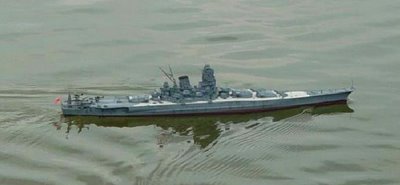Pat Mathews' Musashi





I've been working with r/c boats for a while now... a real long while for some of them. Sometimes the delays come from difficult modeling challenges, other times from a lack of willingness to spend the necessary money to finish something (should of thought about that before I started!).
Anyway, I decided to demonstrate, to myself as well as others, that it doesn't have to be hard. I started by r/c'ing a Lindberg Fletcher...but that took so much effort to make a halfway presentable model, that I wasn't sure I had proven my point. So here I take on the 1:350 Tamiya Musashi... not that I'm a Musashi fan, the kit just happened to be on sale. Turns out to be a good choice anyway- the Musashi, and her sister the Yamato, were the biggest battleships ever. This means they're the biggest 1:350 battleships too, and size is good in model boats.
A few other good points:
- Like all Tamiya products, the model is good straight out of the box. No major repairs needed... though one can go crazy with photoetch, I suggest not to- it's just too fragile.
- Musashi and Yamato come with a four-output gearbox, and hey, with port & starboard counter-rotating props! (I've heard the Bismarck only has 2 outputs, don't know about the other big Tamiyas).
- Big and beamy, good for stability... except in waves, mine is like a rock. Displacement is just over 3 pounds.
And some bad points:
- That gearbox is noisy like you can't believe. Pack it full of grease, especially where the shafts come through the cheesy end plates. And cover it up, as it'll throw grease everywhere.
- The "stuffing boxes" are a joke. Boxes molded into the hull bottom, with square exit holes for the round shafts. You're supposed to fill the boxes with grease, but it just doesn't hold back the water. I used them as-is, but if I do it again, I'll fit proper stuffing boxes somehow for the 2mm shafts.
- The rudder is not designed for r/c, and requires modification to work. Things are complicated by the hangar deck, which obstructs access to the rudder post.
- All that beautiful plastic detail is FRAGILE. Expect broken AA guns and other parts.
The whole poop/hangar deck is supposed to be glued on, but I put another cross beam under it (plastic bar), and ran a screw through the hangar well into the bar. Holds just fine, I don't seem to take water in there, and I can access the steering gear. I HATE inaccessible hardware!
Midships. I took out the molded-in 4 D cell holder, and substituted a C cell unit from Radio Shack. This motor draws so little current, why bother with rechargeables? The fore deck was glued on later, but I can still extract the battery holder. Note a second cross beam. The motor is a 280, snaps into a bracket provided by Tamiya, convenient. I used a standard servo- fits fine, and is cheap. You can use a mini-servo if you like. Not shown, but I stuck the receiver and ESC (a tiny Airtronics ES-01, only $25) on the starboard side of the motor. The blue thing is ballast- lead bullets encased in 3/4" shrink tube, available from better electronics distributors. The unit is flexible, can be positioned as needed, but has lots of friction so it stays in place.
Before gluing the fore deck on, I put a lever switch under the #1 turret... cam is cut from thick styrene. I then glued the deck on, only to find the switch was bad... had to abandon it, and mounted a micro slide switch in the hangar well. I HATE inaccessible hardware!
The aft end of the main deck has plastic plugs for a friction fit onto the hangar deck. I cut those off, and glued some thick plastic onto the hangar deck, and also into the hull just forward of the boat doors. Holes were drilled, and #0-80 hex head brass screws (tiny!) were driven in to hold the deck down. Yes they're visible, but they aren't obviously wrong, like big Allen screws. A dab of paint blends them in nicely, they almost look like deck fittings.
Editorial: Exquisite detail is de rigueur in display models, but there are practical limits in r/c. You're going to handle your model, so think twice about PE and rigging with darn-near invisible sewing monofilament. A few things that just won't do on a display model will just have to be acceptable for r/c- screw heads, exposed switches, and open deck seams to name a few. But if you want to fix some of those, knock yourself out!
Pat Matthews 6/2003
Owned by: Pat Mathews, Detroit, Michigan USA
Built: ?
Length: 29 inches
Width: ?
Built From: Tamiya 1:350 Musashi kit.
